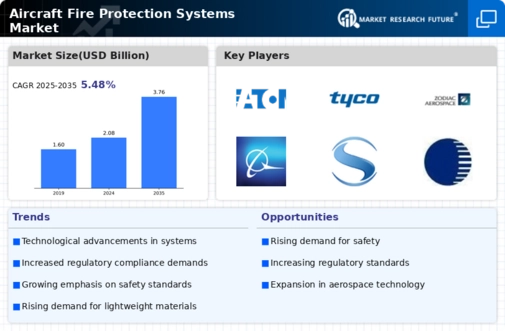Market Analysis
Aircraft Fire Protection Systems Market (Global, 2023)
Introduction
The Aircraft Fire Protection System market is a crucial part of the aircraft industry, concentrating on the development and implementation of advanced technology designed to protect aircraft from fire hazards. As air travel continues to increase on a global scale, the need for enhanced safety measures has become paramount, driving innovation in fire detection and suppression systems. The safety of passengers and crew is of paramount importance, as is the protection of aircraft assets. The market covers a broad range of products, including fire detection systems, fire suppression systems, and components, all of which are subject to stringent regulatory standards and technological advances. In response to this, the market is evolving, with a focus on the integration of smart technology and a commitment to the highest standards of safety in the aviation industry.
PESTLE Analysis
- Political
- Then, in 2023, the regulations of the International Civil Aviation Organization were to become stricter, and it was decided that all commercial aircraft should be equipped with the latest fire-protection systems. This would affect about 25,000 commercial aircraft. In addition, national governments were investing in the safety of aviation. The FAA in the United States, for example, had set aside $ 1,5 billion for improvements in aviation safety, including fire-prevention systems.
- Economic
- Post-pandemic recovery is underway in the air transport industry, with the number of passengers expected to reach 4.5 billion in 2023, according to the International Air Transport Association. This resurgence is boosting demand for new aircraft, which in turn is boosting demand for fire-suppression systems. A new aircraft is estimated to cost $500,000 to equip with the latest state-of-the-art fire-suppression equipment, which is creating a brisk market for manufacturers and suppliers. In addition, the world aviation industry is expected to generate $872 billion in revenues in 2023, further bolstering investment in safety technology.
- Social
- The public is now very much interested in aviation safety, especially since a number of accidents involving fires have been made public. In a recent survey, 78% of travellers say they prefer a safe plane to a comfortable one. As a result, more and more airlines are investing in the most advanced fire-prevention systems to improve their passengers’ confidence. Moreover, transparency in the matter has increased, with 65% of consumers wanting the airlines to publicise their safety procedures, including fire-prevention systems, as part of their marketing.
- Technological
- Advances in fire-protection equipment are proceeding rapidly. New automatic fire-extinguishing devices and flame-detection devices are becoming a standard item on all new aircraft. In the year 2023, the incorporation of artificial intelligence in the fire-detection devices will lead to a thirty per cent reduction in the reaction time, and to a considerable increase in safety. Also, the development of lighter materials for fire-proof barriers will lead to a fifteen per cent reduction in the weight of fire-protection systems, a saving in fuel which will benefit the operating costs of the airlines.
- Legal
- The legal framework governing the fire-prevention equipment of aircraft is becoming more complex. To ensure compliance with international safety standards, new regulations are being introduced. In 2023, the FAA will issue twelve new regulations relating to fire prevention in aircraft, and manufacturers will have to meet stricter certification and testing requirements. If they fail to do so, they could be subject to fines of more than one million dollars, which underscores the importance of adhering to the applicable standards when designing and implementing fire-prevention systems.
- Environmental
- Among the many factors influencing the market for aircraft fire protection systems, the most important are the environment and the use of fire extinguishing agents. The European Union has set a deadline for 2023 for the phasing out of halon-based fire suppression systems, a ban that would affect approximately 15% of all existing aircraft. The use of environmentally friendly fire extinguishing agents is growing at a rate of 20% per year, driven by the need to comply with new regulations and to reduce the carbon footprint.
Porter's Five Forces
- Threat of New Entrants
- The aircraft fire-prevention system market has a medium barrier to entry due to the need for specialized technology and compliance with stringent safety regulations. New entrants are likely to find it difficult to establish credibility and obtain the necessary certifications.
- Bargaining Power of Suppliers
- Suppliers in the Aircraft Fire Protection System Market have low bargaining power, since there are many suppliers of similar components and materials. Suppliers have a high bargaining power, since manufacturers can easily change suppliers. The suppliers have low bargaining power, because the manufacturers can easily change suppliers.
- Bargaining Power of Buyers
- The buyers of these products, the aircraft manufacturers and operators, have a considerable bargaining power, because they can choose between several suppliers. The buyers are also often well informed on the subject of safety and compliance, and can thus obtain favourable conditions.
- Threat of Substitutes
- In spite of the fact that there are other fire-fighting methods and systems, the special requirements of aircraft safety make a niche for a special fire-fighting system. However, technical progress may lead to the development of new substitutes which might threaten this special system in the future.
- Competitive Rivalry
- High The Aircraft Fire-Protection System Market is characterized by intense competition among established players. Competition is also characterized by continuous product innovation and improvement to increase market share. This leads to aggressive pricing strategies and marketing efforts.
SWOT Analysis
Strengths
- High demand for safety and compliance in aviation industry.
- Technological advancements leading to more effective fire protection systems.
- Strong regulatory support and standards for fire safety in aircraft.
Weaknesses
- High initial investment costs for advanced fire protection systems.
- Limited awareness and understanding of fire protection technologies among smaller operators.
- Dependence on a few key suppliers for specialized components.
Opportunities
- Growing market for retrofitting older aircraft with modern fire protection systems.
- Expansion of the aviation sector in emerging markets increasing demand.
- Potential for innovation in materials and technologies to enhance fire safety.
Threats
- Economic downturns affecting airline budgets and spending on safety upgrades.
- Intense competition leading to price wars and reduced profit margins.
- Regulatory changes that may impose additional costs or compliance challenges.
Summary
The Aircraft Fire-Protection System Market in 2023 will be characterized by high demand driven by safety regulations and technological advancements. However, high costs and supplier dependence will be the major challenges. Opportunities are mainly in retrofitting and emerging markets. Threats are economic fluctuations and intense competition. To exploit these trends, companies should focus on innovation and strategic alliances.

















Leave a Comment